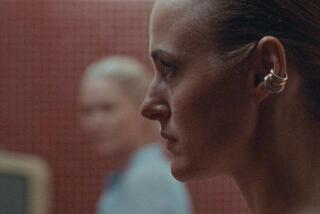Movie review: Latest ‘Wuthering Heights’ is a stark, muddied affair
British filmmaker Andrea Arnold’s “Wuthering Heights,” the newest chapter in the novel’s long, on-screen history, is so earthy and intent on authenticity that like Heathcliff and Cathy you can never escape the wind that howls across the moors, or the mud, clinging so thick on boots and body that it’s tempting to check your own. Even the actors, many plucked from the Yorkshire countryside where the Emily Bronte classic is set and the movie was shot, have faces worn by that harsh clime to match the complicated emotions the author explored.
In a lean script, Arnold hews closely to the fundamentals of the novel: the destitute boy brought in by Mr. Earnshaw (Paul Hilton) and christened Heathcliff; Earnshaw’s daughter, Cathy, whose bond with Heathcliff seems fast and unbreakable; his son, Hindley, who seethes when his father favors the boy; Heathcliff’s departure and triumphant, but tortured, return; the cruelty — physical and emotional — of the times and the people.
Gone are the florid sensibility and most of the frocks that have graced many earlier adaptations, including the still-powerful 1939 version with Merle Oberon and Laurence Olivier. At the fore of Arnold’s vision is the brown-skinned boy Bronte imagined Heathcliff to be, a detail that injects race as well as class into the conflicts.
PHOTOS: Hollywood backlot moments
The young orphan is played by Solomon Glave, the elder by James Howson; both make impressive debuts. Young Cathy, an excellent Shannon Beer, is very much the wild child whom Heathcliff fell for, while the woman of the manor she grew into, played by Kaya Scodelario, is refined and resentful, her recriminations spit out like broken glass.
Although the undercurrents are the same, much about the production feels new. The writer/director’s idea to make “Wuthering Heights” more true to the book — at least in the staging —- is intriguing. It also continues a naturalistic style that characterizes Arnold’s work, a small but strong oeuvre for the actress turned filmmaker that includes her Oscar-winning short 2003’s “Wasp.” Her first feature, “Red Road” in 2006, earned a jury award at Cannes, and 2009’s tale of a fatherless teenage girl in “Fish Tank” is excellent. “Wuthering Heights,” her third feature, is by far Arnold’s most ambitious effort yet, but “Red Road” and “Fish Tank” are the better films.
What’s right with the film is also what is wrong with it. Sometimes there is nothing more artistically elegant than stripping a story down to the bare essentials to get at a more naturalistic world, as director Cary Fukunaga did in his minimalist take on another Bronte sister’s “Jane Eyre” in 2011, or the ambient sounds and silences of director Kelly Reichardt’s “Meek’s Cutoff” in 2010. The danger, though, is that the very lack of artifice can become the artifice.
What enriches “Wuthering Heights” at the beginning weakens and wears down the film by the end. The branch that taps the bedroom window when the wind kicks up is but one of the images that becomes a nuisance over time, the overuse too pointed. The reliance on natural lighting, while beautiful in its shadowy grit, leaves the Earnshaw farmhouse so dark that it is often next to impossible to know what is going on.
PHOTOS: Hollywood backlot moments
The mood and the film’s internal rhythm, like the moors, are muddied as well. The time that Heathcliff and Cathy spend as carefree kids, roaming a barren landscape, is intercut with sharp bouts of cruelty that seem to come out of nowhere — in the most egregious, Heathcliff is beaten and locked up for infractions that are ill defined in the movie. It makes rough sledding for actors asked to navigate those wild emotional swings.
Still, Arnold’s “Wuthering Heights” has its virtues. The reality she brings to Bronte makes the contrasts between social strata much starker. The look itself, raw and haunting, won director of photography Robbie Ryan the Venice Film Festival’s top cinematography prize. Earnshaw’s place has all the roughness of a working farm, while the Linton’s manor, where Heathcliff and Cathy are caught spying and a dog bite changes everything, is wrapped in the aging grace of a more gentile life. Unlike earlier films, the weight of the story rests with young Heathcliff and Cathy, their older selves not much more than an epilogue. It’s just that there isn’t enough story — the book shouldn’t be required reading for the film to make sense.
PHOTOS AND MORE:
PHOTOS: Hollywood back lot moments
Latest movie reviews
PHOTOS: NC-17 movies: Why they got the rating
More to Read
Only good movies
Get the Indie Focus newsletter, Mark Olsen's weekly guide to the world of cinema.
You may occasionally receive promotional content from the Los Angeles Times.











